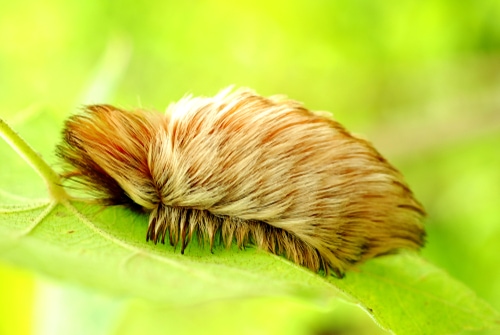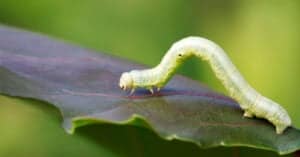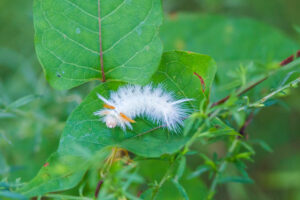In the heart of Mississippi’s lush landscapes, a remarkable transformation unfolds quietly under our watchful eyes. Caterpillars are the true architects of wonder in this southern realm. They lead a life of metamorphosis, weaving a tale of nature’s most intricate artistry.
As they munch on leaves, caterpillars embark on a journey of growth and change. Their insatiable appetite fuels their quest for transformation. With each passing day, they shed their old skin, revealing vibrant patterns that offer a glimpse into their future splendor. …And some of them are very venomous! As always, use safety practices when out hunting for caterpillars in the wild of Mississippi, as some of these species can cause some damage if handled.
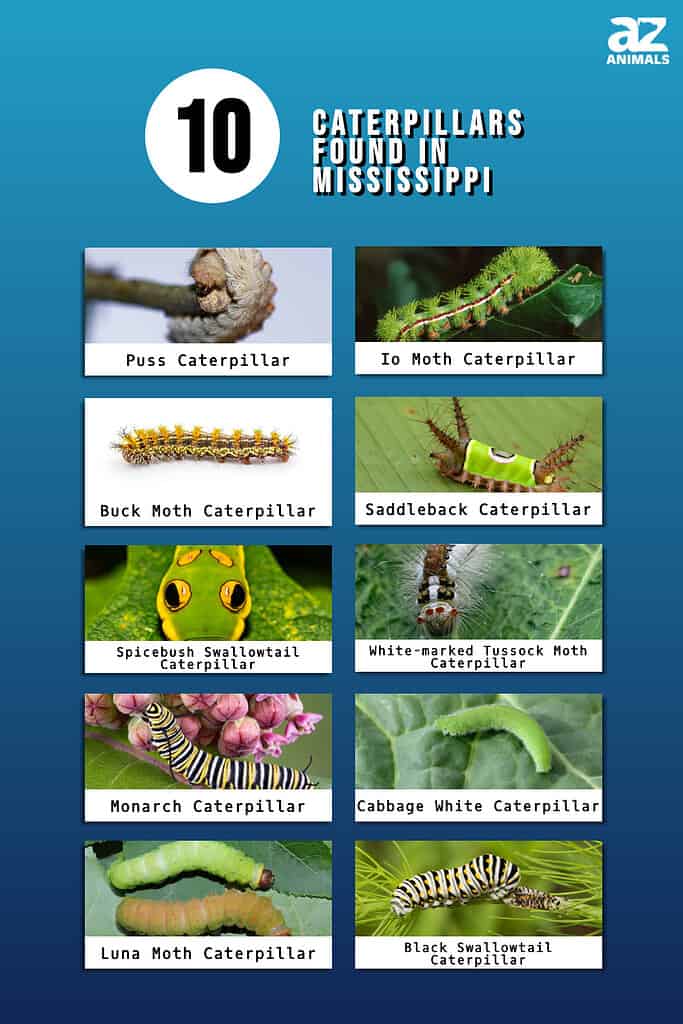
In this article, we’ll look at a few of Mississippi’s most captivating caterpillars. We’ll also take a look at some of the state’s more dangerous specimens as well.
1. Puss Caterpillar
The puss caterpillar is a small but deceptive creature with a unique appearance. Covered in soft-looking, furry hairs, it resembles a tuft of cotton or a tiny furball. However, this seemingly harmless exterior conceals a venomous nature. The puss caterpillar is indeed venomous, and its sting can cause intense pain and discomfort. The venom is delivered through spines hidden beneath its furry coat.
These caterpillars are generally around an inch in size, featuring a range of colors from light brown to grayish hues. They often have a darker line running down their center, adding to their unique appearance. These animals populate Mississippi’s gardens, parks, and forests, among other natural habitats. They are hard to identify amid the greenery because of how well they blend in. The stings of these caterpillars may produce painful reactions in some people, including skin irritation, edema, and even allergic reactions. Because of this, caution is recommended if you happen to come across one.

The puss caterpillar is known for having a very furry body.
©Chase D’animulls/Shutterstock.com
2. Io Moth Caterpillar
The io moth caterpillar possesses a distinct appearance that captures attention. It showcases vibrant colors, featuring a green body adorned with eye-catching patterns of white and red stripes. This caterpillar is adorned with several branching spines, which might resemble tiny tree branches, adding to its intriguing visual appeal.
Unlike the puss caterpillar, the io moth caterpillar is indeed venomous. While its spines may appear harmless, they contain toxins that can cause irritation and discomfort if touched. It’s important to exercise caution when encountering these caterpillars to avoid potential stings.
In Mississippi, the io moth caterpillar can be found in various outdoor habitats, including gardens, woodlands, and parks. Its distinct appearance and noticeable colors can aid in identifying it among the foliage. This caterpillar is stunning to look at, however handling it carefully is advised owing to its dangerous nature. If stung, wash the area with soap and water and visit a doctor if the response is severe.
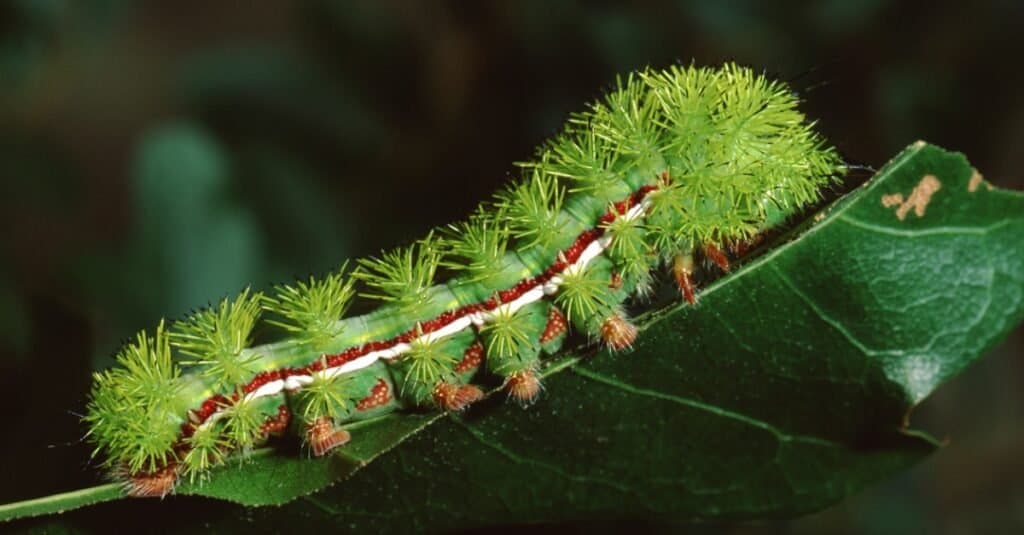
The io moth is considered a venomous caterpillar due to its spines.
©iStock.com/Weber
3. Buck Moth Caterpillar
The buck moth caterpillar, a notable inhabitant of Mississippi, boasts a unique look that commands attention. It displays a combination of dark shades, featuring a velvety black or dark brown body adorned with striking patterns of white or yellow spots. These spots can sometimes form into bands that run along their length. The caterpillar is covered in fine, short hairs that contribute to its intriguing texture.
In terms of its venomous nature, the buck moth caterpillar is indeed venomous. Its venom is transferred through its hairs, which can cause discomfort or allergic reactions if it comes into contact with the skin. The spines on this caterpillar species’ body should be handled with the utmost care to prevent possible stings.
In Mississippi, the unique buck moth caterpillar can be found in several outdoor habitats, including woodlands, gardens, and generally open areas. Its distinctive coloration and unique markings make it somewhat easier to spot among leaves and vegetation. These caterpillars are most active during warmer months. If someone gets stung, washing the affected area thoroughly and using adhesive tape to remove any embedded spines can help alleviate the discomfort.
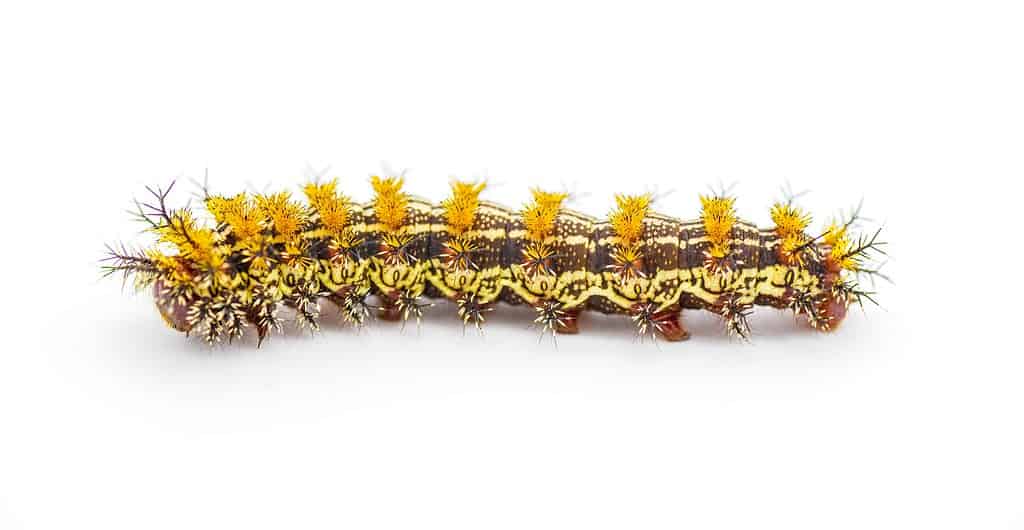
The buck moth caterpillar can vary in appearance, especially when it comes to how dark its hues are.
©Chase D’animulls/Shutterstock.com
4. Saddleback Caterpillar
The saddleback caterpillar is a very common inhabitant of Mississippi that is easy to recognize. It boasts a convex body that resembles a miniature green saddle, with a brown or purple saddle-like mark in the middle. This distinctive marking gives the caterpillar its name. Its sides are adorned with spiky-looking extensions that might seem harmless but conceal venomous spines.
Yes, the saddleback caterpillar is indeed venomous. Its spines contain venom that can cause a stinging sensation and skin irritation upon contact. The venom of this species can be particularly dangerous for those with sensitive skin or allergies. Because of this, we don’t recommend handling or touching these caterpillars. Enjoy them from afar!
In the state of Mississippi, saddleback caterpillars can be found in gardens, shrubs, and wooded areas. Their unique appearance makes them relatively easy to spot among leaves. They are most active during warmer months when they feed on various plants.
Interacting with the saddleback caterpillar requires caution to prevent accidental stings. If stung, using adhesive tape to remove any spines left in the skin and applying a cold compress can help alleviate the discomfort. Despite their eye-catching appearance, respecting their venomous nature and maintaining a safe distance is important for a hassle-free outdoor experience.

The saddleback caterpillar is known for its adorable green saddle, though it is quite venomous.
©Hagit Berkovich/Shutterstock.com
5. Spicebush Swallowtail Caterpillar
The spicebush swallowtail caterpillar showcases a vibrant color palette, featuring a striking blend of green and black. Its body is covered with pronounced markings that are unique to each caterpillar. The enormous eye-like markings on its thorax are quite jarring and may serve to ward off predators by giving the impression of a snake’s eyes.
This caterpillar is not considered venomous. While its spiky projections might seem concerning, they lack venom and are more for defense and camouflage. However, some people might experience skin irritation if they come into contact with the caterpillar’s bristles.
In Mississippi, the spicebush swallowtail caterpillar can be found in various habitats, including forests, gardens, and open woodlands. It primarily feeds on the leaves of spicebush and sassafras plants. Its vibrant colors and unique markings make it somewhat easier to spot amidst the foliage.
The spicebush swallowtail caterpillar is beautiful to look at, but it may cause skin irritation if touched or handled. Because of its unique look and lack of significant danger to humans, it is an interesting addition to Mississippi’s natural environment and the state’s rich variety of species.
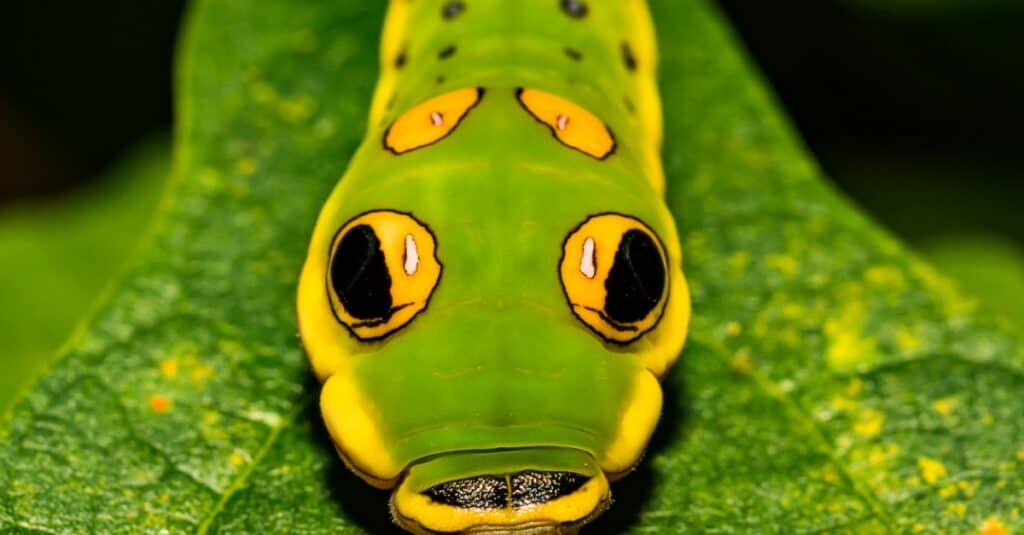
The markings of this caterpillar give it the appearance of a snake to ward off predators.
©iStock.com/JasonOndreicka
6. White-marked Tussock Moth Caterpillar
The white-marked tussock moth caterpillar displays a combination of colors, with a black body adorned with tufts of white, yellow, and black hairs. These tufts form distinct patterns along its body, giving it a textured and eye-catching look.
This caterpillar is not considered venomous. While its hairs might seem bristly and sharp, they lack venom and are mainly for protection against predators. However, some individuals might experience mild skin irritation if they come into contact with the caterpillar’s hair.
In Mississippi, the white-marked tussock moth caterpillar can be found in a variety of outdoor settings, including gardens, forests, and meadows. Its unique appearance makes it somewhat easier to spot amidst leaves and vegetation.
Observing the white-marked tussock moth caterpillar can be an intriguing experience, but it’s best to avoid touching it to prevent any skin irritation. Its vibrant coloration and distinctive texture contribute to the diversity of wildlife found within Mississippi, making it a noteworthy part of the state’s natural environment.

The vibrant and bright appearance of this caterpillar, coupled with its fuzzy spines, protects it from predators.
©Satyashutter/Shutterstock.com
7. Monarch Caterpillar
The monarch caterpillar is visually arresting because of its alternating black, yellow, and white striped body. The caterpillar grows in size and gains black tentacle-like appendages at both ends as it matures.
Although not dangerous to humans, this caterpillar may be technically poisonous to other animals. The poisons it absorbs from the milkweed plants it feeds on are its major line of protection against predators. Even while it’s possible that touching the caterpillar won’t hurt it, you still need to be gentle with it as it is a very delicate species.
The monarch caterpillar lives in a variety of environments in Mississippi but is most common in areas with abundant milkweed. You may often find them in gardens, meadows, and fields. The monarch butterfly’s caterpillars can only survive if they eat the leaves of milkweed, which the butterfly only lays her eggs on. The milkweed plant is considered this species’ host plant.
The metamorphosis of a monarch caterpillar into a butterfly is an amazing sight to see. To transform into a butterfly, it goes through a pupation phase in which it forms a chrysalis. Those fortunate enough to see the monarch butterfly’s metamorphosis in Mississippi’s landscapes are treated to a lesson in the wonders of nature.

The
monarch butterfly
caterpillar loves to eat milkweed, as it is its host plant.
©iStock.com/CathyKeifer
8. Cabbage White Caterpillar
The cabbage white caterpillar, a common presence in Mississippi, boasts a simple yet distinctive appearance. It displays a pale green body with a series of narrow, yellowish stripes running along its length. Its relatively smooth skin lacks any striking patterns, allowing it to blend in with its surroundings.
This caterpillar is not venomous. While it might have bristly hairs on its body, they are not harmful to humans. However, the cabbage white caterpillar can cause damage to garden plants, particularly members of the cabbage family, as it feeds voraciously on their leaves.
In Mississippi, the cabbage white caterpillar can be found in various outdoor environments, including gardens, agricultural fields, and open spaces. It is particularly drawn to plants like cabbage, broccoli, and other cruciferous vegetables.
While not as visually striking as some other caterpillar species, the cabbage white caterpillar plays a role in the ecosystem by serving as a food source for birds and other predators. Its presence can also be a challenge for gardeners, as its feeding habits can impact crop yield. Despite its relatively modest appearance, the cabbage white caterpillar contributes to the complex web of life in Mississippi’s natural landscapes.
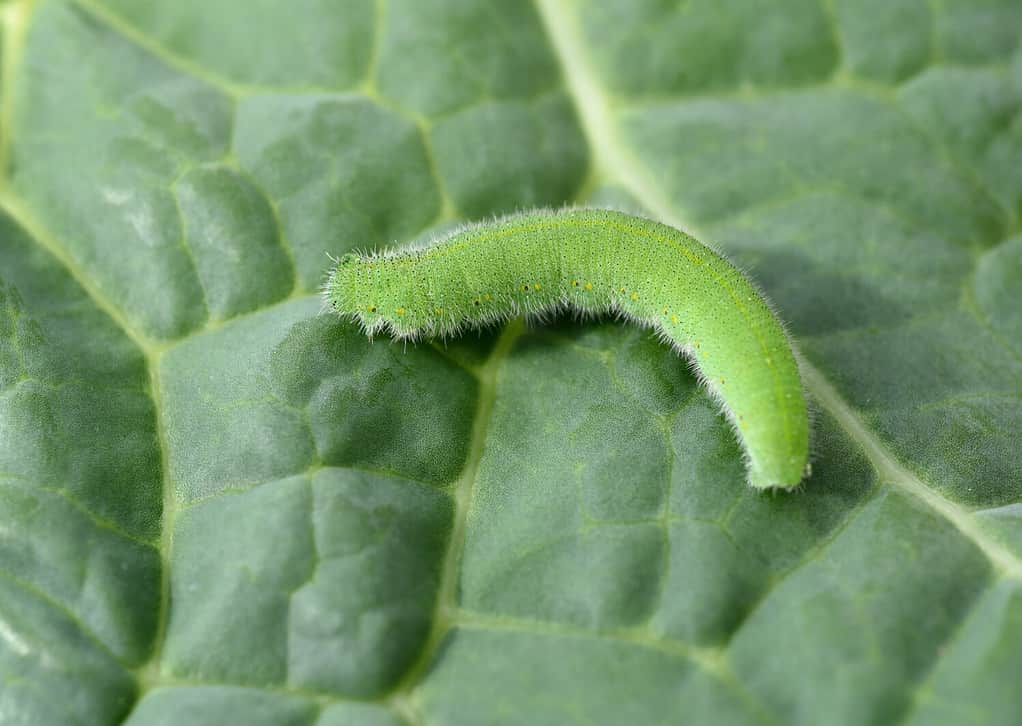
Cabbage white caterpillars are unassuming little caterpillars, but they are quite common throughout Mississippi.
©Manfred Ruckszio/Shutterstock.com
9. Luna Moth Caterpillar
The luna moth caterpillar is a stunning caterpillar that features a bright green body, adorned with thin white lines along its sides. It showcases a series of fleshy spikes, known as tubercles, that bear red or orange dots, adding a dash of color to its overall look.
This caterpillar is not venomous. While its spikes might appear imposing, they do not contain venom and are primarily for defense against predators. So, interacting with the Luna moth caterpillar poses minimal risk to humans.
In Mississippi, the luna moth caterpillar can be found in various outdoor settings, particularly in deciduous forests and wooded areas. It primarily feeds on the leaves of trees such as birch, hickory, and walnut. Its vibrant green coloration allows it to blend well with the foliage, making it a bit challenging to spot.
The luna moth caterpillar’s journey is noteworthy due to its transformation into the luna moth, one of the largest and most striking moths in North America. After pupation, the adult moth emerges with its iconic pale green wings and distinctive “eyespots.”
Encountering the luna moth caterpillar offers a glimpse into the fascinating life cycle of this species. While its appearance is captivating, treating it with care and respect for its role in the ecosystem is essential.
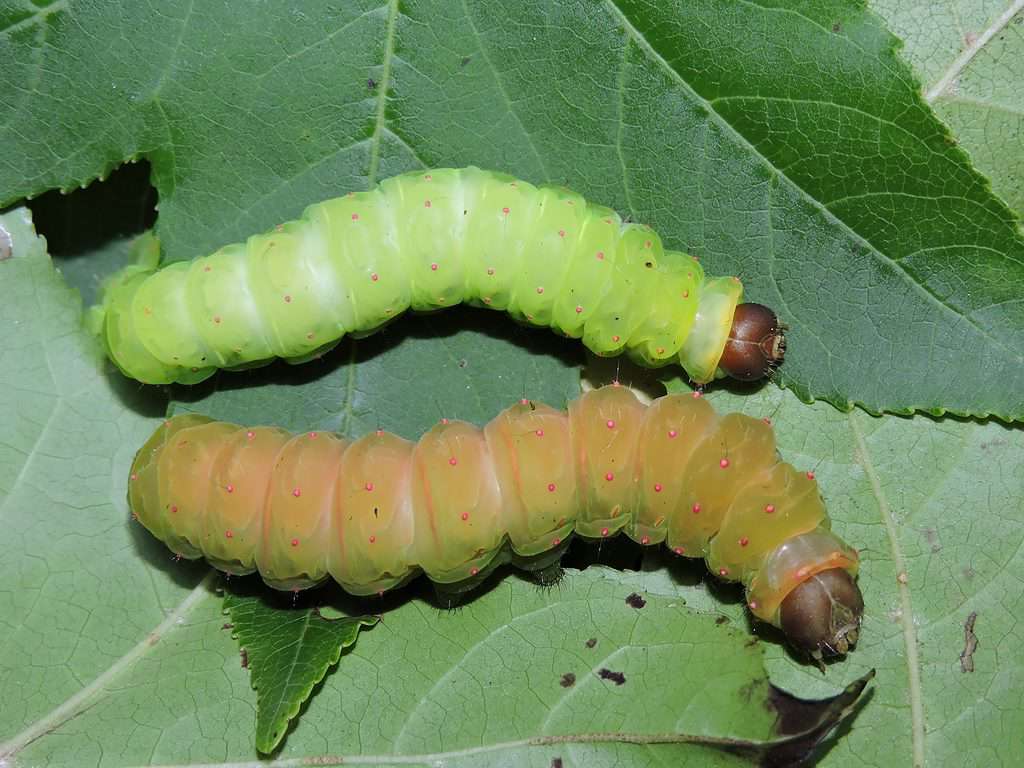
These two luna moth caterpillars look different because the one on the bottom is preparing to pupate.
©TamiG/Shutterstock.com
10. Black Swallowtail Caterpillar
The black swallowtail caterpillar has a vibrant blend of black and green, with bold yellow or orange markings along its body. Eastern specimens of this species also developed orange horns known as osmeteria. These are glands that produce a chemical repellant that wards off predators.
This caterpillar is not venomous. While it might possess bristly spines, they do not contain venom and are mainly for protection. Handling the black swallowtail caterpillar is generally safe for humans, but it’s advisable to treat it gently to avoid harming the delicate creature.
In Mississippi, the black swallowtail caterpillar can be found in various outdoor environments, including gardens, meadows, and fields. It feeds on plants from the carrot family, such as parsley, dill, and fennel.
The black swallowtail caterpillar’s transformation into a butterfly is a captivating spectacle to witness. After pupating, the adult butterfly emerges with its elegant black wings adorned with vibrant yellow markings. It’s a common sight in gardens and open spaces, contributing to the diversity of Mississippi’s wildlife.
Encountering the black swallowtail caterpillar offers a glimpse into the beauty of nature’s intricate patterns and adaptations. Treating it with care and observing its life cycle can provide a meaningful learning experience, while also appreciating the role it plays in the ecosystem as a pollinator and a component of Mississippi’s natural splendor.
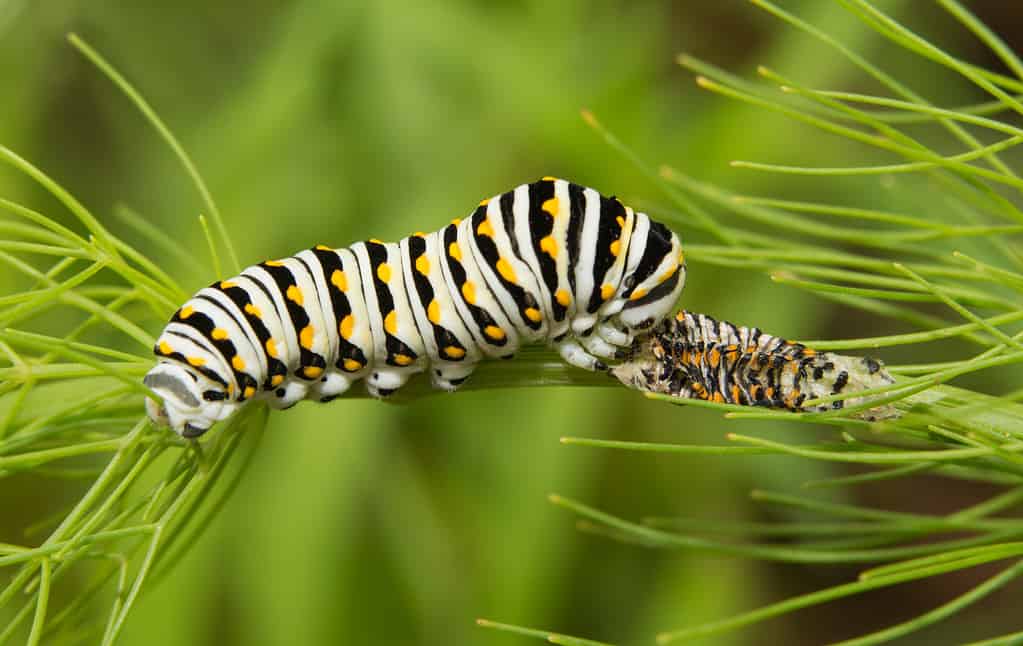
Black swallowtail caterpillars are sometimes confused for monarch caterpillars due to their somewhat similar stripes.
©Sari ONeal/Shutterstock.com
Summary of Caterpillars Found in Mississippi
| # | Caterpillar | Venomous? |
|---|---|---|
| 1 | Puss Caterpillar | Yes |
| 2 | Io Moth Caterpillar | Yes |
| 3 | Buck Moth Caterpillar | Yes |
| 4 | Saddleback Caterpillar | Yes |
| 5 | Spicebush Swallowtail Caterpillar | No, but might cause irritation |
| 6 | White-Marked Tussock Moth Caterpillar | No, but might cause irritation |
| 7 | Monarch Caterpillar | Not to humans |
| 8 | Cabbage White Caterpillar | No |
| 9 | Luna Moth Caterpillar | No |
| 10 | Black Swallowtail Caterpillar | No |
Thank you for reading! Have some feedback for us? Contact the AZ Animals editorial team.

